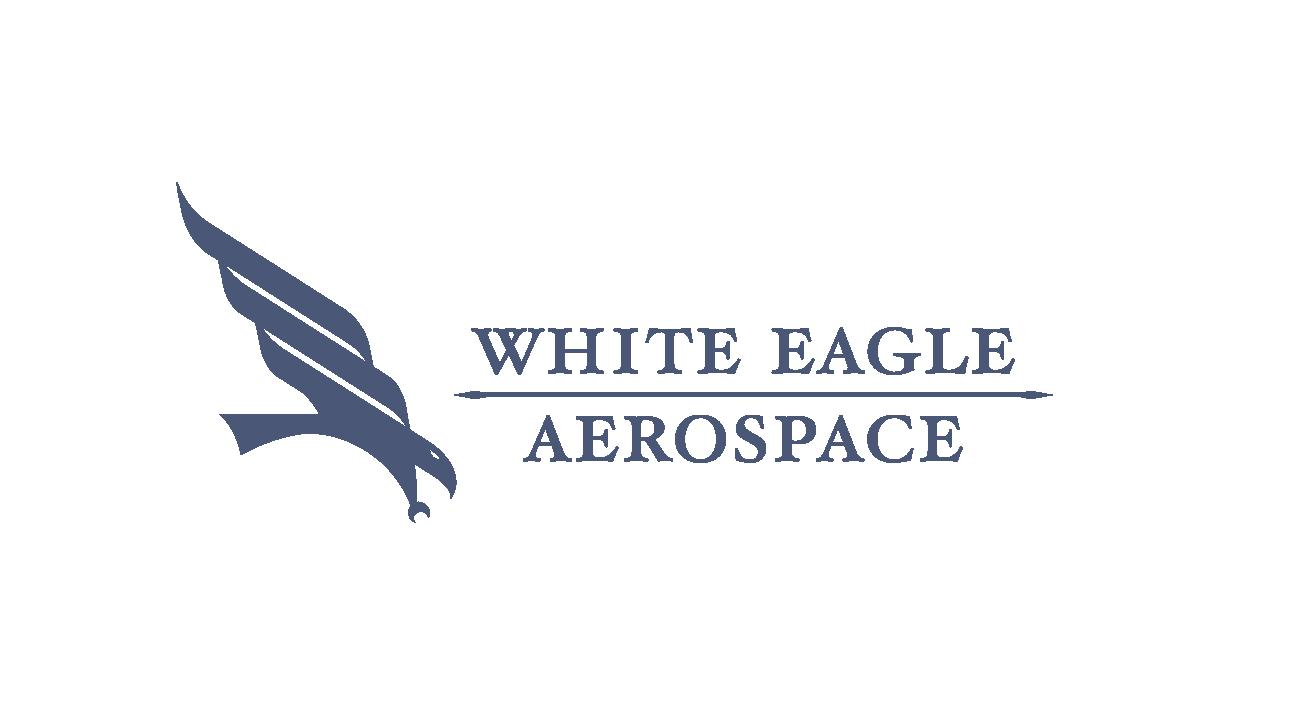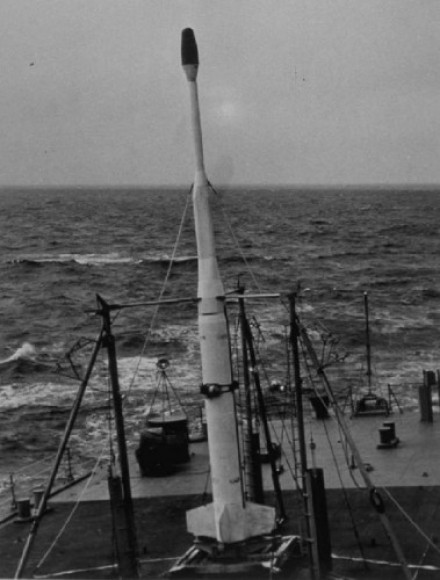
Fifty-four years ago this month, the first of a trio of secret nuclear test shots was conducted from a remote location in the South Atlantic Ocean. These tests were conducted in support of a secret Defense Nuclear Agency program given the code name Operation Argus.
In early 1958, Nicholas Christofilos, a researcher at Lawrence Radiation Laboratory (LRL) theorized that artificial radiation belts could be produced through detonation of a nuclear device in space. These belts would be the result of charged particles becoming trapped within the magnetic field that surrounds the Earth.
Christofilos posited that the artificial radiation belts would interfere with radar tracking and communications as well as the electronics of ballistic missiles and satellites. As such, the Christofilos Effect could be used for tactical effect against an adversary.
At the time Christofilos conceived of his theory, the Cold War between the United States and the Soviet Union raged at a fever pitch. Each country sought to gain any tactical advantage it could over the other. As a result, most strategies for doing so, even the extreme ones, were seriously considered. Often this was so if for no other reason that each country feared that the opposition would exploit a concept that it itself had outright rejected.
The purpose of Operation Argus was to test the validity of the Christofilos Effect. A triple stage USAF/Lockheed X-17 rocket was modified to carry a W-25 nuclear warhead with a yield of 1.7 kilotons. Three (3) launches would take place with respective detonation altitudes of 87, 158 and 405 nautical miles. Approximately 4,500 individuals participated in Operation Argus with the entire effort classifed as secret.
The point of launch for Operation Argus test shots was located roughly 600 nm southwest of Cape Town, South Africa. This location was chosen for two reasons. First, that portion of the Earth’s magnetic field capable of efficiently holding the charged particles was located between latitudes of 35 and 55 degrees. Second, the limited altitude capability of the booster vehicle required a launch location in the southern hemisphere where the magnetic field dips down much closer to the surface than in the northern hemisphere.
A total of nine (9) United States Navy ships participated in Operation Argus. Each ship left port separately with no knowledge of the others. Collectively known as Task Force 88 (TF-88), these ships came together for the first time at the Operation Argus South Atlantic test location in August of 1958. The missile launching ship for Operation Argus was the famous USS Norton Sound.
Argus I was launched at 02:28:27 UTC on Wedneday, 27 August 1958. The W-25 warhead detonated at 87 nm above the surface of the South Atlantic. This test was quickly followed by Argus II (Saturday, 30 August) and Argus III (Saturday, 06 September) which detonated nuclear devices at altitudes of 158 and 405 nm, respectively.
The results of Operation Argus verified that the Christofilos Effect was indeed a valid concept. The artificial radiation belts produced by the three nuclear detonations lasted for a period of several weeks in space before dispersing. The success of the experimental effort was first made public by the New York Times in March of 1959. However, the full details of the test series remained classified until April of 1982.
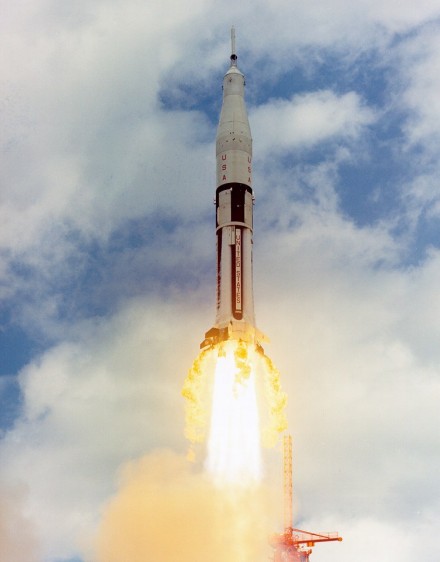
Forty-six years ago this month, the United States successfully conducted a crucial suborbital flight test of the Apollo Command-Service Module (CSM). Known as AS-202, the unmanned space mission was the third involving the Apollo Block I spacecraft and the Saturn IB booster.
The primary goal of Apollo-Saturn Mission 202 (AS-202) was to man-rate the Apollo CSM for spaceflight. Accomplishment of such represented a key step along the way in America’s quest to land men on the Moon before the end of the 1960’s.
The Apollo Guidance and Navigation system flew for the first time on AS-202, as did the fuel cell system the spacecraft would use for electrical power in space. Other critcal systems tested during the mission included the Service Propulsion System (SPS) and Thermal Protection System (TPS).
Weighing 44,294 lbs, the AS-202 CSM was launched into a suborbital flight path by a Saturn IB launch vehicle. Lift-off from Cape Canaveral’s LC-34 occurred at 17:15:32 UTC on Thursday, 25 August 1966. The entire launch stack tipped the scales at a little over 1.344 million pounds at launch.
Riding on 1.6 million lbs of first stage thrust, the CSM reached an altitude of 30.2 nm in 150 seconds. During first stage flight, the Saturn IB’s eight (8) Rocketdyne H-1 engines burned 880,500 lbs of propellants (RP-1 and LOX).
Following first stage separation, the Saturn IVB upper stage then drove the CSM to an altitude of 117 nm in a 450-second burn of its single Rocketdyne J-2 engine. In doing so, this powerplant consumed 228,500 lbs of propellants (LH2 and LOX) at a thrust level of 200,000 lbs.
Shortly after second stage separation, the Apollo CSM SPS was fired for 215 seconds in the first of four (4) separate burns. This resulted in the CSM achieving an apogee of 617 nm. The total energy added by the SPS resulted in the Apollo Command Module (CM) hitting atmospheric interface (400 KFT) in excess of 29,000 feet per second.
The CM reentry trajectory featured a pull-up maneuver executed at 216 KFT. This caused the vehicle to ascend to 266 KFT and scrub-off about 4,200 feet per second in velocity. The CM then resumed a normal reentry characterized by continuing loss of altitude and velocity. By parachute deployment at 24 KFT, the vehicle base heat shield had been subjected to a thermal load of 22,900 BTU’s per square foot.
Splashdown of the AS-202 CM occurred in the north Pacific Ocean at 18:48:34 UTC. The vehicle had flown 13,900 nm downrange of Cape Canaveral and spent 93 minutes and 2 seconds in flight. Because the landing point was 200 nm off-target, the recovery ship (USS Hornet) did not arrive on station for another 8.5 hours.
The flight of AS-202 was extremely successful. So much so, that NASA declared the Apollo Block I Command-Service Module ready to fly men into space. At this point, things looked very good for the Apollo Lunar Landing Program. Sadly, the events of Friday, 27 January 1967 would profoundly affect the lives of a trio of astronauts scheduled to make the first manned flight of an Apollo Block I CSM.
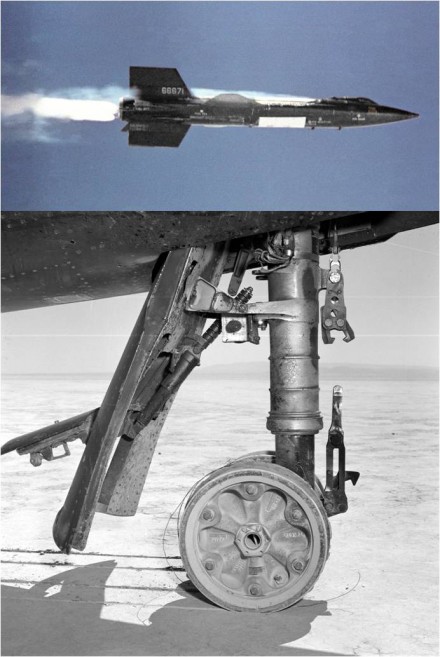
Forty eight-years ago this month, the North American X-15 hit a speed of 3,590 mph (Mach 5.23) in a flight to 103,300 feet. While decelerating through Mach 4.2, the nose gear of the aircraft unexpectedly deployed in flight.
The 114th powered flight of the legendary X-15 Program took place on Friday, 14 August 1964. USAF Major Robert A. Rushworth was at the controls of X-15 Ship No. 2 (S/N 56-6671). The mission would be Rushworth’s 22nd flight in the black hypersonic aircraft.
X-15 drop from the NB-52A (S/N 52-0003) launch aircraft took place over Delamar Dry Lake, Nevada. Seconds later, Rushworth called for 100% power from the X-15’s XLR-99 liquid-fueled rocket engine as he pulled into a steep climb. He subsequently pushed-over and then leveled-off at 103,300 feet.
XLR-99 burnout occurred 80.3 seconds after ignition. At this juncture, the X-15 was traveling at 3,590 mph; better than 5 times the speed of sound. Following burnout, the aircraft slowed and began to lose altitude under the influence of aerodynamic drag.
As the Mach meter needle passed through Mach 4.2, Rushworth heard a loud bang from the airframe. The aircraft became hard to control as it gyrated in pitch, yaw and roll. Rushworth was equal to the moment and brought his troubled steed under control. However, the aircraft had an uncommanded sideslip and Rushworth had to use left aileron to hold the wings level.
Gathering his wits, Rushworth realized that the loud bang he heard was very similar to that which occurred when the nose gear was deployed in the landing pattern. Unaccountably, the X-15 nose gear had deployed in supersonic flight. An unsettling confirmation of Rushworth’s hypothesis came when the pilot spotted smoke, quite a bit of it, in the X-15 cockpit.
As Rushworth neared Edwards Air Force Base, chase aircraft caught up with him and confirmed that the nose gear was indeed down and locked. Further, the tires were so scorched from aerodynamic heating that they probably would disintegrate during touchdown on Rogers Dry Lake. They verily did.
Despite his tireless nose gear, Rushworth was able to control the rollout of his aircraft fairly well on the playa silt. He brought the X-15 to a stop and deplaned. Man and machine had survived to fly another day.
Post-flight analysis revealed that expansion of the X-15 fuselage due to aerodynamic heating was greater than expected. The nose gear door bowed or deformed outward more than anticipated as well. Together, these two anomalies caused the gear uplock hook to bend and release the nose gear. Fixes were subsequently made to Ship No. 2 to prevent a recurrence of the nose gear door deployment anomaly.
Rushworth next flew X-15 Ship No. 2 on Tuesday, 29 September 1964. He reached a maximum speed of 3,542 mph (Mach 5.2) at 97,800 feet. The nose gear door remained locked. However, while decelerating through Mach 4.5, Rushworth heard a bang that was less intense than the previous flight. This time, thermal stresses caused the nose gear door air scoop to deploy in flight. While the aircraft handled poorly, Rushworth managed to get it and himself back on the ground in one piece.
Following another redesign effort, Rushworth took to the air in X-15 Ship No. 2 on Thursday, 17 February 1965. He hit 3,539 mph (Mach 5.27) at 95,100 feet. On this occasion, both the nose gear door and nose gear door scoop remained in place. Unfortunately, the right main landing skid deployed at Mach 4.3 and 85,000 feet.
Thermal stresses were once again the culprit. Despite degraded handling qualities with the landing skid deployed, the valiant Rushworth safely landed the X-15. Upon deplaning, he is reported to have kicked the aircraft in a show of disgust and frustration. Unprofessional maybe, but certainly understandable.
Yet another redesign effort followed in the aftermath of the unexpected main landing skid deployment. This was the third consecutive mission for X-15 Ship No. 2 and Rushworth to experience a thermally-induced landing gear or landing skid deployment anomaly. Happily, subsequent flights of the subject aircraft were free of such issues.
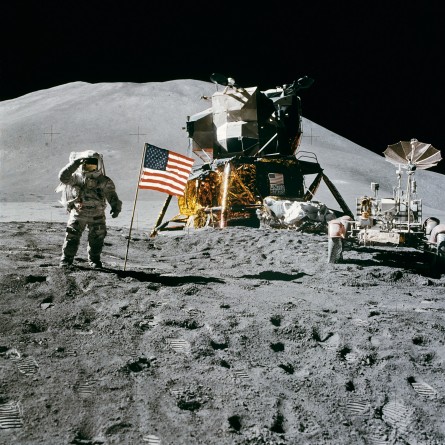
Forty-one years ago today, Apollo 15 landed in the Hadley-Appennine region of the Moon. The fourth manned lunar landing, Apollo 15 was one of the most scientifically successful and geologically diverse of the Apollo Lunar Landing Program.
Apollo 15 lifted-off from LC-39A at Cape Canaveral, Florida at 13:34 UTC on Monday, 26 July 1971. The all-Air Force flight crew consisted of Commander David R. Scott, Command Module Pilot Alfred M. Worden and Lunar Module Pilot James B. Irwin. While Apollo 15 was Scott’s third spaceflight, Irwin and Worden were space rookies.
Apollo 15 was the first of the Apollo “J” missions wherein lunar surface stay duration was extended to three (3) days. This was sufficient time for lunar explorers to conduct a trio of Lunar Extravehicular Activity (LEVA) periods. Each LEVA was approximately 6 to 7 hours in length. The Lunar Module (LM) was provisioned with extra equipment and consumables to support these extended stay operations.
Another “J” mission feature was the use of the Lunar Rover (LR). This electric-powered marvel conveyed astronauts over the lunar surface at speeds up to 8 mph. It’s range from the LM was limited by a “Walkback Limit” of about 5 miles. That is, should the LR fail at any point during a lunar excursion, the astronauts had to have sufficient oxygen remaining to permit them to walk back to the LM a distance of up to 5 miles.
The Apollo 15 Lunar Module Falcon, with Dave Scott and Jim Irwin onboard, landed at 22:16:29 UTC in the Hadley-Appennine region of the Moon on Friday, 30 July 1971. High overhead, Al Worden orbited the Moon alone in the Command Module (CM) Endeavor.
Scott and Irwin conducted 3 separate LEVA’s totaling slightly over 18.5 hours. During these lunar jaunts, they collected 170 lbs of lunar samples. Their biggest find was the so-called “Genesis Rock” estimated to be 4.1 billion years old. As per previous Apollo lunar landing missions, the Apollo 15 astronauts deployed an Apollo Lunar Surface Experiments Package (ALSEP) which permitted monitoring of the lunar environment long after the crew’s return to Earth.
A unique aspect of Apollo 15 was Commander Scott’s conduct of a simple experiment on the lunar surface. With a geology hammer in his right hand and a Falcon feather in his left, the astronaut released both objects simultaneously. Television viewers back on Earth witnessed both items striking the ground at the same moment. This result confirmed Galileo’s assertion that all objects in a vacuum fall at the same rate independent of their mass.
The Apollo 15 lunar explorers’ stay on the Moon lasted almost 67 hours. Falcon lifted-off from the Moon at 17:11:23 UTC on Monday, 02 August 1971. For the first time, lift-off of the LM ascent stage was televised back to Earth via a TV camera attached to the LR. Slightly less than 2 hours later, Scott and Irwin successfully rendezvoused and docked with Worden.
The crew of Apollo 15 started the trip back to Earth at 21:22:45 UTC on Wednesday, 04 August 1971 with a successful Transearth Injection burn of their Service Propulsion System (SPS). Just before leaving lunar orbit, the astronauts deployed a subsatellite designed to conduct a long duration study the lunar plasma, particle, magnetic and gravitational environments. The next day, Al Worden successfully completed a 39-minute EVA in deep space as he retrieved exposed film from cameras located in a special bay within the Service Module (SM).
Endeavor and her crew successfully reentered the Earth’s atmosphere on Saturday, 07 August 1971. During descent, one of the CM’s three (3) main parachutes failed to deploy properly and caused the CM splashdown sink rate to be higher than normal. However, the robust crew survived the subsequent hard landing in the North Pacific Ocean without apparent ill effect. Crew and craft were safely recovered aboard the USS Okinawa.
Mission elapsed time for Apollo 15 was 295 hours, 11 minutes and 53 seconds. The maturation of lunar surface operations that made an extended stay possible and provided for enhanced exploration activities wrought a substantial scientific bounty. Indeed, the knowledge and experience gained during the Apollo 15 mission went a long way to helping the Apollo Program make the most of history’s last pair of manned lunar landing missions; Apollo 16 and Apollo 17.
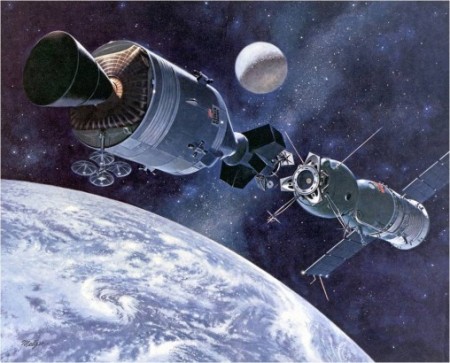
Thirty-seven years ago this month, the first joint United States-Soviet Union spaceflight was successfully conducted. This historic event also marked the first time that spacecraft from two nations successfully rendezvoused and docked in orbit.
The Apollo-Soyuz Test Project (ASTP) was the first international manned spaceflight. The primary objectives of ASTP were to (1) test the compatibility of rendezvous and docking systems of American and Soviet spacecraft, (2) pave the way for international space rescue and (3) set the stage for future joint manned spaceflights.
The United States flew an Apollo Command-Service Module (CSM) with three men on board; Commander Thomas P. Stafford, Vance D. Brand and Donald K. “Deke” Slayton. This was Stafford’s 4th time in space while Brand and Slayton were space rookies. Slayton, one of the original Mercury Seven, had been deprived of a Mercury flight due to what flight surgeons claimed was a heart murmur. ASTP was Slayton’s ultimate vindication from what he always considered to be a specious medical issue.
The Soviet Union flew a Soyuz spacecraft as part of ASTP. It was the 19th such vehicle flown by the Soviets. On board were Cosmonauts Aleksey A. Leonov and Valery N. Kubasov. ASTP was the second spaceflight for both men. Leonov held the distinction of being the first human to perform a spacewalk. That achievement occurred in March of 1965 during the flight of Voskhod 2.
The Apollo CSM carried a special docking module that permitted the spacecraft to dock with the Soyuz. It also functioned as an airlock since the two vehicles employed different pressurization systems. Apollo used pure oxygen pressurized to 5.0 while Soyuz utilized a nitrogen-oxygen atmosphere pressurized at 10.0 psia. Once the Apollo and Soyuz were docked, the docking module also served as conduit between the two spacecraft through which men and cargo could pass.
The ASTP mission began with launch of the Soyuz spacecraft from Baikonur Cosmodrome on Tuesday, 15 July 1975. Seven and a half hours later, the Apollo spacecraft was launched from LC-39B at Cape Canaveral, Florida. On Thursday, 17 July 1975, 52 hours after the mission began, the two spacecraft successfull docked in space. This event marked the first time in spaceflight history that such a feat had been accomplished.
Over the next 48 hours, the crews participated in a variety of activities and exercises. Crew members from each country were able to transfer to the spacecraft of the other via a tunnel in the docking module. Ceremonies were held onboard to mark the occasion. Several dockings and undockings between the two spacecraft were accomplished as well. A variety of space experiments rounded out the schedule.
On Saturday, 19 July 1975, Apollo and Soyuz undocked for the final time. The two spacecraft subsequently maneuvered to achieve widely separated orbits. Following additional time on-orbit in which a variety of space experiments were conducted, each spacecraft returned to Earth. Soyuz did so on Monday, 21 July 1975. Apollo followed on Wednesday, 24 July 1975.
ASTP was the last spaceflight conducted by the United States using an Apollo spacecraft. It also marked the end of America’s initial manned spaceflight effort that began in 1961 with Project Mercury. ASTP was also the country’s last manned spaceflight of the 1970’s. Indeed, not until the first flight of the Space Shuttle in April of 1981 that America would once again fly men into space.
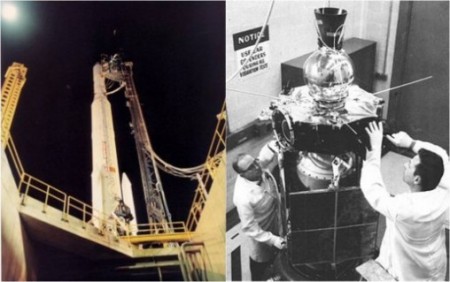
Forty-five years ago this week, the Explorer 35 satellite was launched on a mission to investigate the space environment in the vicinity of the Moon. Among other discoveries, the 230-lb satellite would find that the Moon does not have a magnetosphere like Earth.
Explorer is the longest running satellite program in the history of American spaceflight. Indeed, the first satellite orbited by the United States was Explorer I in January of 1958. Since that time, a total of ninety (90) Explorer satellites have been launched into space for the purpose of investigating the space environments of the Earth, Moon and Sun.
Explorer 35, also known as Anchored Interplanetary Monitoring Platform 6 (AIMP-6), was designed to expand our knowledge concerning a variety of interplanetary space phenomena. The characteristics of the solar wind, interplanetary magnetic field, lunar gravitational field and lunar radiation environment were of particular focus.
Explorer 35 carried an array of scientific instruments to probe the lunar space environment. Key spacecraft instrumentation included multiple magnetometers, geiger tubes, and ion chambers. The spacecraft instrument package also included thermal ion and micrometeoroid detectors as well as a Faraday cup.
On Wednesday, 19 July 1967, Explorer 35 was launched towards the Moon by a Thor-Delta launch vehicle; the 50th such vehicle flown. Lift-off from LC-17B at Cape Canaveral, Florida occurred at 14:19:02 UTC. Flying a direct ascent trajectory, the spacecraft arrived in lunar orbit on Friday, 21 July 1967.
Explorer 35’s orbit about the Moon was highly-elliptical; featuring an apolune of 4,152 nm and a perilune of 432 nm. During its operational lifetime, the satellite found that the Moon has no magnetosphere, that the solar wind impacts the lunar surface directly and that a void in the solar wind exists in the lee of the Moon.
Explorer 35 provided a wealth of scientific data that greatly expanded our knowledge of the Moon and its space environment. After continuously probing that environment for nearly six (6) years, Explorer 35 was permanently turned-off via command from Earth on Sunday, 24 June 1973. While the craft has long since fallen from lunar orbit, the exact time and location of impact are not known.
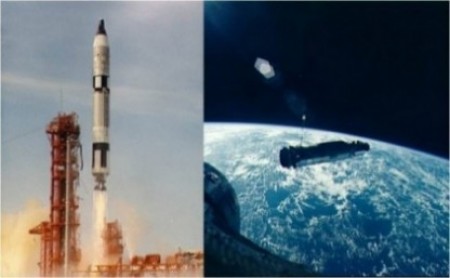
Forty-six years ago this month, NASA Astronauts John W. Young and Michael Collins completed the highly successful mission of Gemini 10. Among other accomplishments, the Gemini 10 crew established a new manned spaceflight record when they rode their Gemini-Agena spacecraft to an altitude of 412 nm above the Earth.
The Gemini Program consisted of ten manned spaceflights flown in a twenty month period starting in March of 1965. Gemini pioneered key technologies required to land men on the Moon including space navigation, rendezvous, docking, orbital maneuvering, long-duration spaceflight and extra-vehicular activity (EVA). Without Gemini, the United States would not have achieved the goal of landing men on the Moon before the end of the 1960’s.
Gemini-Titan 10 (GT-10) was launched from LC-19 at Cape Canaveral, Florida on Monday, 18 July 1966. Lift-off time was 22:20:26 UTC. Roughly 100 minutes earlier, an Agena Target Vehicle (ATV) had been launched from LC-14 into a 162 nm circular parking orbit. Gemini 10 successfully rendezvoused and docked with the ATV at 04:15:00 UTC on Tuesday, 19 July 1966.
Using the Agena’s restartable rocket motor, the docked Gemini-Agena combination was boosted into a 412 nm x 159 nm elliptical orbit. This trajectory exposed the astronauts to flight through portions of the Earth’s radiation belts. Dosimeter measurements revealed that radiation levels at apogee did not constitute a significant health issue for the astronauts. While docked with the Agena, Collins conducted a 49-minute stand up EVA starting at 21:44:00 UTC on 19 July.
After several more burns of the Agena rocket motor, the astronauts undocked from the ATV at 19:00:00 UTC on Wednesday, 20 July 1966. These Agena-aided maneuvers placed Gemini 10 in a position to later use its own orbital maneuver system to complete a rendezvous with the Gemini 8 Agena Target Vehicle at an orbital altitude of 204 nm. This event marked the first time in spaceflight history that a spacecraft successfully rendezvoused with two separate vehicles on the same mission.
At 23:01:00 UTC on 20 July, Collins started a 39-minute EVA in which he floated over to examine the Gemini 8 ATV. He had difficulty trying to hold on to the vehicle, but was able to retrieve a micrometeorite collector for analysis back on Earth. Collins also used a hand-held maneuvering unit powered by nitrogen gas. This effort was short-lived as he quickly ran out of the gaseous propellant. Finally, Collins reentered the Gemini 10 and with some effort was able to secure his hatch.
After 43 orbits, Gemini 10 reentered the Earth’s atmosphere on Thursday, 21 July 1966. The spacecraft landed at 21:07:05 UTC in the Atlantic Ocean, only 3 nm off target. Crew and spacecraft were recovered by the USS Guadalcanal.
Though highly successful, Gemini 10, like all Gemini missions, had its share of problems. But, just like all other Gemini missions, it was in the overcoming of its problems that Gemini 10 moved the United States materially closer to the realization of the nation’s lunar landing goal. While trying times lay ahead for the United States space effort, including a national tragedy, that lofty goal would be realized in the summer of 1969.
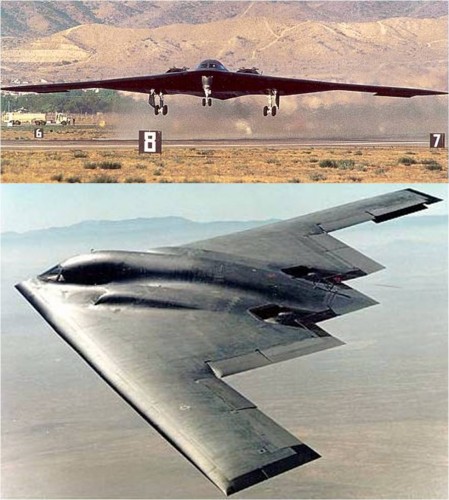
Twenty-three years ago this month, the USAF/Northrop B-2 Stealth Strategic Bomber flew for the first time. The aircrew for the B-2’s maiden trip upstairs included Northrop B-2 Division Chief Test Pilot Bruce J. Hinds (command pilot) and B-2 Combined Test Force Commander USAF Col. Richard S. Couch (co-pilot).
The B-2 traces it lineage to a variety of Northrop flying wing aircraft including the piston-powered YB-35 and jet-propelled YB-49. These 1940’s-era experimental aircraft served as important stepping stones in the evolution of large flying wing technology.
An all-wing aircraft represents an aerodynamically-optimal configuration from the standpoint of high lift, low drag and therefore high lift-to-drag ratio. These favorable aerodynamic attributes translate to high levels of range performance and load-carrying capability. In addition, the type’s high aspect ratio and slim profile provide for more favorable low observable characteristics than traditional fuselage-wing-empennage aircraft geometries.
Arguably the most challenging aspects of creating an all-wing aircraft have to do with flight control and handling qualities. The crash of the second YB-49 flying wing in June of 1948 underscored the insufficiency of aerospace technology at that time to handle these design challenges. It was not until the advent of modern flight control avionics during the 1980’s that the full potential of a flying wing aircraft would be realized.
The B-2 is only 69 feet in length, but has a wing span of 172 feet and a wing area of 5,140 square feet. Gross take-off and empty weights are 336,500 lbs and 158,000 lbs, respectively. Embedded within the wings are a quartet of fuel-efficient F118-GE-100 turbofan engines, each generating 17,300 lbs of thrust. The aircraft has a top speed of about Mach 0.85, an unrefueled range of 6,000 nm and a service ceiling of 50,000 feet. Maximum ordnance load is 50,000 lbs.
B-2 AV-1 (Spirit of America; S/N 82-1066) took-off for the first time from Air Force Plant 42 in Palmdale, California on Monday, 17 July 1989. Supported by F-16 chase aircraft, the majestic flying wing flew a 2 hour 12 minute test mission which concluded with a landing at nearby Edwards Air Force Base. As a first flight precaution, the entire mission was flown with the landing gear down.
The first B-2 airframe to enter the operational inventory was AV-8, the Spirit of Missouri (S/N 88-0329). It did so on 31 March 1994. While initial plans called for a production run of 132 aircraft, only 21 B-2 airframes were actually built. With the 2008 loss of the Spirit of Kansas shortly after take-off from Andersen Air Force Bas in Guam, 20 of these aircraft remain in active service today.
Whiteman Air Force Base in Missouri serves as Air Force’s home for the B-2. From there, the majestic flying wing has flown a multitude of global strike missions to deliver a variety of ordnance with pinpoint accuracy. To date, the B-2 has successfully engaged targets in Kosovo, Afganistan, Iraq and Libya. The B-2 is truly a technological marvel and a national defense asset. As such, it may be expected to be a vital part of the Air Force’s active inventory for decades to come.
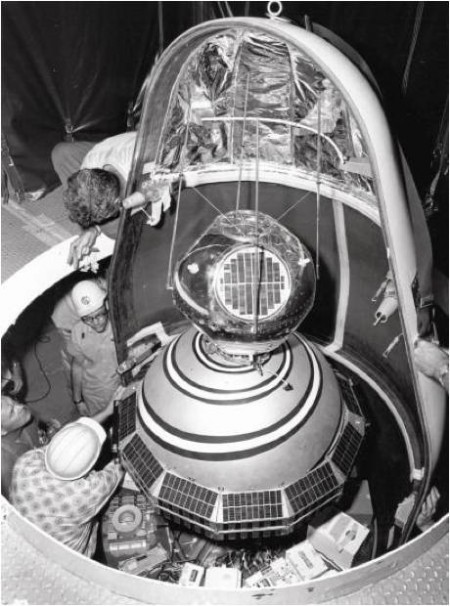
Fifty-two years ago this month, the Transit 2A and GRAB 1 satellites were successfully launched into orbit by a Thor Able Star launch vehicle. This marked the first time that multiple functional satellites were orbited on the same mission.
On Wednesday, 22 June 1960, Thor Able Star 281 roared away from LC-17B at Cape Canaveral, Florida with the Transit 2A and GRAB 1 satellites on board. Both orbiters were designed and developed under the auspices of the United States Navy. Each satellite was successfully placed into its respective target orbit by the powerful hybrid Thor rocket system.
Transit was the first operational satellite navigation system. More formally known as the Navy NAVSAT (Navigation Satellite) System, Transit provided accurate global position data in support of naval worldwide sea operations. The navigation of submarines and surface ships was greatly aided by Transit-provided data as were sundry hydrographic and geodetic surveying programs.
Transit was developed for the Navy by the Applied Physics Laboratory of the Johns Hopkins University (JHU/APL). Work began in 1958 and launch of the first prototype Transit satellite, Transit 1A, took place in September 1959. A number of Transit satellite launches took place over the next 5 years with the system going operational in 1964.
Transit satellites provided position data that was accurate to within about 3 feet. The system revolutionized global navigation and was ultimately used by an untold number of ships and boats. Transit navigational operations ceased in 1996 with the advent of the Global Positioning System (GPS). One of the great benefits of GPS is that position data are provided continuously whereas Transit provided discrete data about once an hour.
The other notable passenger aboard Thor Able Star 281 was the GRAB 1 satellite. GRAB (Galactic Radiation Background Experiment – go figure) holds the distinction of being the first successful Electronic Intelligence(ELINT) satellite in history. Stationed in a 500-mile orbit, its mission was to monitor Soviet radar emissions for the purpose of mapping that country’s air defense radar system. GRAB also monitored electronic activity coming out of Red China and other communist nations as well.
GRAB transmitted reconnaissance information obtained during a data collection pass to special ground stations within its field of view. These data were recorded and found their way to military and civil security agencies for analysis. For obvious reasons, the GRAB program was classified. In fact, it was not until 1998 that the program was declassified.
A confusing aspect of the GRAB 1 satellite is that it is often referred to as the SOLRAD 1 satellite. (SOLRAD stood for Solar Radiation.) This confusion was in fact intentional. The GRAB/SOLRAD satellite in actuality had two scientific packages on board. The publicly-known entity was SOLRAD. As the name implies, its purpose was to gather solar radiation data. Its alter purpose was as a front for the clandestine ELINT mission of the GRAB package.
The dual mission of the GRAB/SOLRAD 1 satellite was very successful. GRAB ELINT operations took place over a 3 month period and included a total of 22 data collection passes over denied territory. In its 10-month operational mission, SOLRAD gathered an extensive amount of solar emissions data which, when correlated with ground measurements, added significantly to our understanding of the Sun.
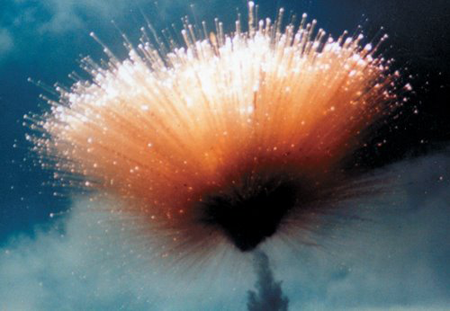
I recently came across this thought-provoking excerpt while conducting final research for our soon to be released Aerospace Lessons-Learned course. These are sobering words, yet extremely accurate. As aerospace professionals, striving for advances in a field fraught with the unknown, we will encounter failure. Without a doubt, we will fail. However, we can minimize the frequency of those failures and thus maximize our rate of success by learning from the past.
You will fail. It is important to understand this certainty. As an aerospace engineer, you will be building vehicles that fly under conditions never before encountered. You will, despite all the analysis and efforts put into the projects, still be voyaging into the unknown. You do not know what you will find. In ancient times, much of the world was a blank. Mapmakers would mark these unknown places with the words “Here There Be Dragons.” Despite all the advances in the first century of heavier-than-air flight, you need to understand that the dragons are still out there. You will fail.
That you will fail is certain. The causes of the failure you will experience, however, may be entirely unknown, and will range from the overarching to the mundane. A failure may come because, with existing knowledge and technology, the goal was unattainable. It may occur due to changing social factors, national needs, and aerospace policies. The failure may come as a result of a grave mismatch between budget and tasks at hand, or a lack of necessary political commitment. The failure may occur because an assumption was made that should have been challenged, because a modification was made that was better left undone or a question went unasked, or some flaw went undetected. And, perhaps worst of all, the failure may occur for reasons you will never truly understand.
While you are being trained in the skills needed to successfully build an aerospace vehicle, you may be less well prepared for events that can occur in the wake of a failure. On the personal level, you will have to deal with the emotional impact of having spent years working on a project, having missed evenings, weekends, and holidays with family and friends, of having overcome an endless series of problems and setbacks, only to see it all fail within a matter of seemingly random and dispassionate seconds.
This wrenching but instructive experience will then be followed by a mishap investigation, which may continue for months. During this time, the project is no longer under the control of project personnel. The investigators are the ones running things. You and the other project personnel have little input into what is done in the course of the effort. You may also face uncertainty over the project’s future in the wake of the failure. As with the immediate aftermath, this will take a toll on you and other project personnel.
The question is not if you will fail. Instead, the question is how you will deal with that failure, and how you will overcome it.
Excerpt above is from Road to Mach 10: Lessons Learned from the X-43a Flight Research Program written by Curtis Peebles, aerospace historian for the Smithsonian Institute.











